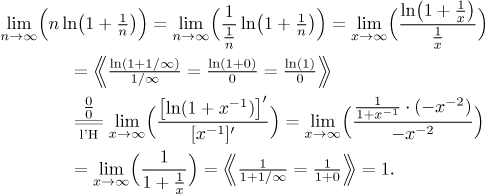
Here we will look at the following problem: We need to find a limit of the
product
The standard solution is to transform the product into ratio by algebra. If we do it as outlined below, such a ratio will be of the indeterminate type and the l'Hospital rule can be used (see the box "indeterminate ratio").
How do we change product into ratio? We choose one of the two terms in the product and apply "one over one over" trick to it; indeed, we know from algebra that for any non-zero A we have 1/(1/A) = A. The resulting ratio will be of the type that depends on which part of the product we process this way, whether the "zero part" or the "infinity part":

Note that we actually cheated here, when we wrote that
What if this does not work? Another possibility is to first solve a problem where the "0" is put into absolute value, then start worrying about the sign. Some details are here.
Still, in most cases this is not a problem.
Example:
![]()
We got an indeterminate product, so we will change it into a fraction. Which part do we choose to play with? n looks simple, so we try it. And since we know that we will be using l'Hospital's rule, we change from sequences to functions right away.

What happens if we try to play with the second part of the product?

As you can see, the new expression is even worse than the one we started with, so this way it will not work.
A note on 0+:
When we put the zero in the denominator, we had to check whether it is
one-sided (see the note above). We know that
The choice of the part that we transform decides whether we succeed or not.
Usually we try to "put under" a part which does not get more complicated
when it is transformed this way. Typically this would be powers, since they
just change signs of exponents:
In Solved Problems - Limits, these methods are used in this problem, this problem, and this problem.
Next box: indeterminate difference
Back to Methods Survey - Limits